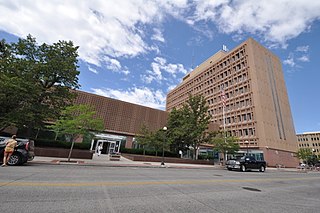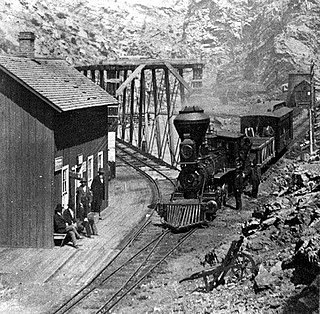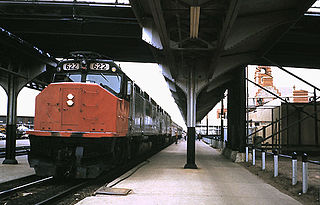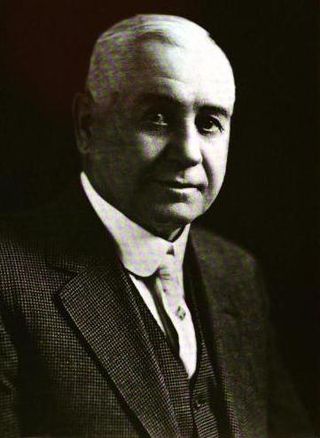
North America's first transcontinental railroad was a 1,911-mile (3,075 km) continuous railroad line constructed between 1863 and 1869 that connected the existing eastern U.S. rail network at Council Bluffs, Iowa, with the Pacific coast at the Oakland Long Wharf on San Francisco Bay. The rail line was built by three private companies over public lands provided by extensive US land grants. Building was financed by both state and US government subsidy bonds as well as by company-issued mortgage bonds. The Western Pacific Railroad Company built 132 miles (212 km) of track from the road's western terminus at Alameda/Oakland to Sacramento, California. The Central Pacific Railroad Company of California (CPRR) constructed 690 miles (1,110 km) east from Sacramento to Promontory Summit, Utah Territory. The Union Pacific Railroad (UPRR) built 1,085 miles (1,746 km) from the road's eastern terminus at the Missouri River settlements of Council Bluffs and Omaha, Nebraska, westward to Promontory Summit.

Laramie County is a county located at the southeast corner of the state of Wyoming. As of the 2020 United States Census, the population was 100,512 or 17.4% of the state's total 2020 population, making it the most populous county in Wyoming, but the least populous county in the United States to be the most populous in its state.

Laramie is a city in and the county seat of Albany County, Wyoming, United States. The population was estimated 32,711 in 2019, making it the third-largest city in Wyoming after Cheyenne and Casper. Located on the Laramie River in southeastern Wyoming, the city is north west of Cheyenne, at the junction of Interstate 80 and U.S. Route 287.

The Territory of Colorado was an organized incorporated territory of the United States that existed from February 28, 1861, until August 1, 1876, when it was admitted to the Union as the State of Colorado.

The Colorado Central Railroad was a U.S. railroad company that operated in Colorado and southeastern Wyoming in the late 19th century. It was founded in the Colorado Territory in the wake of the Colorado Gold Rush to ship gold from the mountains. It expanded from its Golden–Denver line to form a crucial link connecting Colorado with the transcontinental railroad and the national rail network. The history of the railroad throughout the 1870s was driven at times by a fierce struggle between local interests, led by W.A.H. Loveland, and outside investors of the Union Pacific Railroad led at times by Jay Gould. The early struggle of the company to build its lines was a major part of the early competition between Denver and Golden for supremacy as the principal metropolis of Colorado.
The Denver Pacific Railway was a historic railroad that operated in the western United States during the late 19th century. Formed in 1867 in the Colorado Territory, the company operated lines in Colorado and present-day southeastern Wyoming in the 1870s until merging with the Kansas Pacific and Union Pacific railroads in 1880. The railroad was formed primarily to create a link between Denver and the transcontinental railroad at Cheyenne, an achievement that was widely credited at the time with making Denver the dominant metropolis of the region.
The Kansas Pacific Railway (KP) was a historic railroad company that operated in the western United States in the late 19th century. It was a federally chartered railroad, backed with government land grants. At a time when the first transcontinental railroad was being constructed by the Central Pacific and the Union Pacific, it tried and failed to join the transcontinental ranks. It was originally the "Union Pacific, Eastern Division", although it was completely independent. The Pennsylvania Railroad, working with Missouri financiers, designed it as a feeder line to the transcontinental system. The owners lobbied heavily in Washington for money to build a railroad from Kansas City to Colorado, and then to California. It failed to get funding to go west of Colorado. It operated many of the first long-distance lines in the state of Kansas in the 1870s, extending the national railway network westward across that state and into Colorado. Its main line furnished a principal transportation route that opened up settlement of the central Great Plains, and its link from Kansas City to Denver provided the last link in the coast-to-coast railway network in 1870. The railroad was consolidated with the Union Pacific in 1880, and its mainline continues to be an integral part of the Union Pacific network today.

John Evans was an American politician, physician, founder of various hospitals and medical associations, railroad promoter, governor of the territory of Colorado, and namesake of Evanston, Illinois; Evans, Colorado; and Mount Evans, Colorado.

The Cheyenne Depot Museum is a railroad museum in Cheyenne, Wyoming. It is located inside the 1880s Union Pacific Railroad depot. A National Historic Landmark, the station was the railroad's largest west of Council Bluffs, Iowa, and a major western example of Richardsonian Romanesque architecture.

Cheyenne is the capital and most populous city of the U.S. state of Wyoming, as well as the county seat of Laramie County, with 65,132 residents, per the 2020 US Census. It is the principal city of the Cheyenne metropolitan statistical area which encompasses all of Laramie County and had 100,512 residents as of the 2020 census. Local residents named the town for the Cheyenne Native American people in 1867 when it was founded in the Dakota Territory.

Morton Everel Post was an American businessman, farmer, and politician who served as a delegate to the United States House of Representatives from Wyoming Territory's at-large congressional district.

There is evidence of prehistoric human habitation in the region known today as the U.S. state of Wyoming stretching back roughly 13,000 years. Stone projectile points associated with the Clovis, Folsom and Plano cultures have been discovered throughout Wyoming. Evidence from what is now Yellowstone National Park indicates the presence of vast continental trading networks since around 1,000 years ago.
The Cheyenne and Northern Railway was a railroad in the U.S. state of Wyoming. The railroad was incorporated in 1886 to build a line from Cheyenne, Wyoming into northern Wyoming and Montana. The line extended 125 miles (201 km) to Wendover on the North Platte River. It was absorbed by Union Pacific Railroad subsidiary Union Pacific, Denver and Gulf Railway and later became part of the Colorado and Southern Railway when the Union Pacific went into receivership.

Hezekiah Bissell was a leading and well known nineteenth century American railroad engineer, civil engineer, and railroad maintenance of way manager for a number of railroads in the Northeastern United States, including the Cleveland, Cincinnati, Chicago and St. Louis Railway, Eastern Railroad of Massachusetts, and the Boston & Maine.
The Overland Trail was a stagecoach and wagon trail in the American West during the 19th century. While portions of the route had been used by explorers and trappers since the 1820s, the Overland Trail was most heavily used in the 1860s as a route alternative to the Oregon, California, and Mormon trails through central Wyoming. The Overland Trail was famously used by the Overland Stage Company owned by Ben Holladay to run mail and passengers to Salt Lake City, Utah, via stagecoaches in the early 1860s. Starting from Atchison, Kansas, the trail descended into Colorado before looping back up to southern Wyoming and rejoining the Oregon Trail at Fort Bridger. The stage line operated until 1869 when the completion of the First transcontinental railroad eliminated the need for mail service via stagecoach.
Sherman is a ghost town in Albany County, Wyoming, United States. Sherman is 19 miles (31 km) southeast of Laramie in the Laramie Mountains and is named for Civil War general William Tecumseh Sherman, purportedly at his request. From the 1860s to 1918, the town sat at the summit of the original grade of the first transcontinental railroad along the rails of the Union Pacific Railroad, at an elevation of 8,247 ft (2,514 m).

The history of the Union Pacific Railroad stretches from 1862 to the present. For operations of the current railroad, see Union Pacific Railroad; for the holding company that owns the current railroad, see Union Pacific Corporation.
Luke Murrin was an American politician who served as the 2nd Mayor of Cheyenne, Wyoming, and was the first following its chartering.

Marshall Farnam Hurd (1823–1903) was an American civil engineer who was part of the effort to build the Union Pacific railroad to Promontory Point, Utah in 1869. Hurd was present at the Golden spike ceremony on May 10, 1869, connecting the Central Pacific and Union Pacific railroads at Promontory Summit, Utah Territory. Hurd was also in the Russell photograph of the same date














